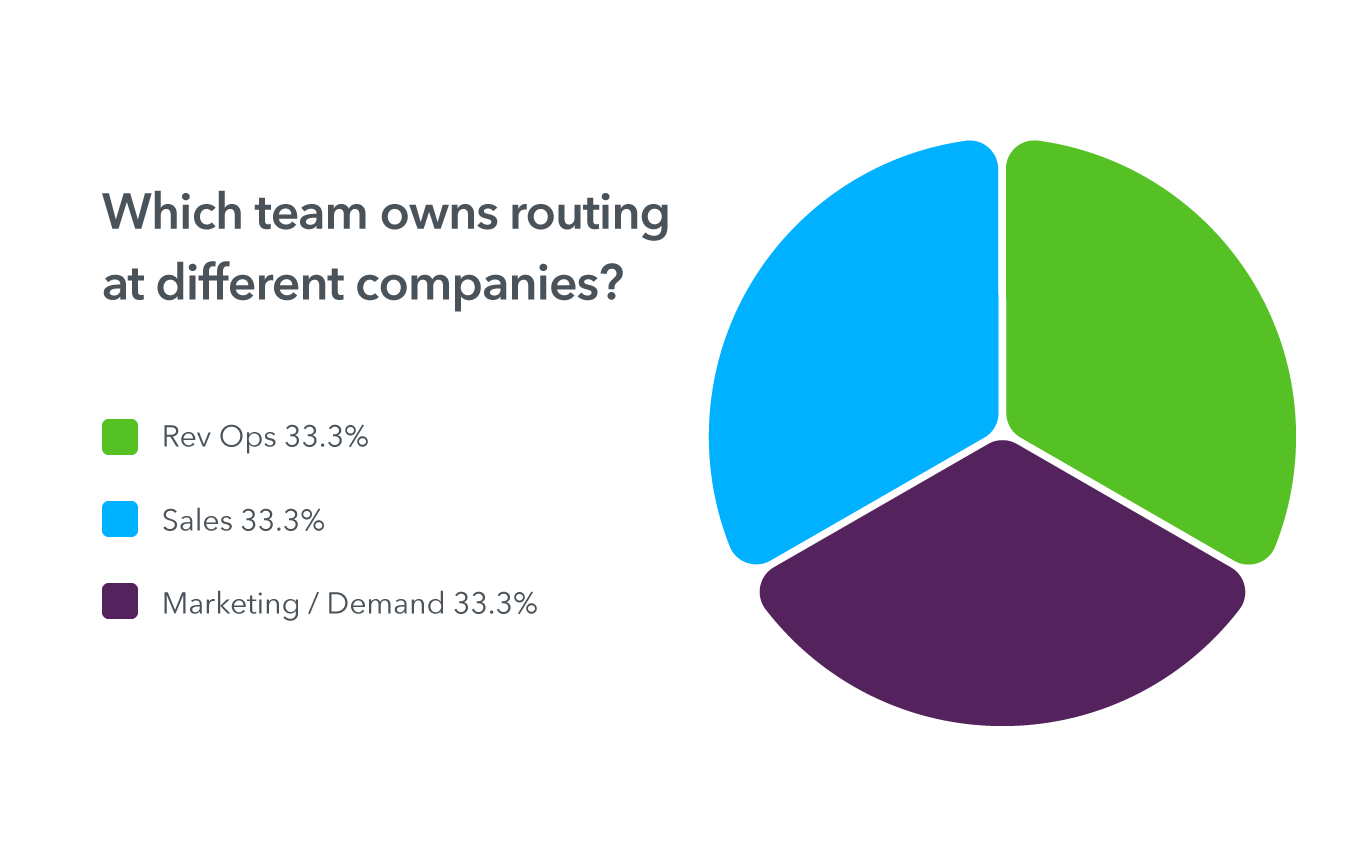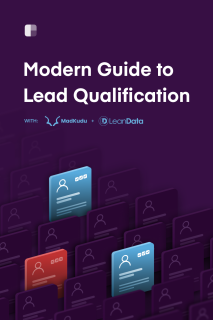Chapter 9
7 minutes
Lead routing in practice: tools and owners
A lead routing and engagement system picks up where a lead scoring system leaves off (see Lead scoring in practice, sending a new lead to the right place and facilitating the next step in communication — whether that's booking a sales meeting or dropping a lead into an outreach campaign. There are a number of tools available to help with this phase of the lead's journey.
Tools for routing
Routing in a CRM or MAP
→ examples: Salesforce, Marketo, HubSpot
CRMs and MAPs can route with built-in rules. We discuss the right time to use built-in rules versus a dedicated lead routing platform in Right-size your routing.
End-to-end lead routing platform
→ examples: LeanData, RingLead
Routing platforms are a dedicated place to build, measure, and optimize routing rules for Salesforce objects. They send leads to the right rep based on a nearly unlimited number of data points, and provide advanced context to the rep and sales engagement tools for personalized outreach—like lead-to-account matching and behavioral data.
Automation and lead management platforms
→ examples: Tray, Workato
These tools make it easy to update lead routing rules in Salesforce or other platforms with visual and easy-to-use workflows. They connect tools in a martech stack, sending data to engagement platforms, and can also bring advanced functionality to your routing, such as sending outreach reminders to reps and intelligent round robins.
For example, you can build a Lead Bot with Workato, working entirely in Slack — reps can set their status as "accepting leads" while at their desk, punt leads to a colleague, and reject leads by indicating why (fake account, competitor?).
Some examples of data that a lead routing system takes into account include:
- Lead score
- Title of the individual
- Lead-to-account matching (what company the lead belongs to)
- Company firmographics
- Type of marketing campaign or channel the lead came in from
- Activities and buying signals, at both the individual and the company level
- Stage of buying journey (or customer status)
- Whether there's already a team member handling that lead's account (SDR, AE, or CS)
- Response time and any SLAs
- Past outreach history
Operational agility: don't "set it and forget it"
Like lead scoring, routing is not a one-and-done implementation. A key attribute of a good routing stack is that it's easy to update as company strategies change.
Jay Vira, Product Manager (and former Solutions Consultant) at LeanData, points out that lead routing needs to shift quickly to reflect any and all changes an organization makes to their go-to-market strategy. This ability is key to what LeanData calls operational agility. "Companies are constantly changing what defines a lead score, how the sales team is segmented, what their territories are — and they're generating demand with different campaigns," Jay says. "So the lead routing process isn't static. Companies need solutions to help them adapt to that pace of change."
That's why companies tend to switch from native CRM routing rules to a routing tool as they grow: it can handle more complexity and it's relatively easy to update. If your company changes its ICP definition or adds a BDR team to an SDR-AE setup, your routing rules need to reflect this as soon as possible — not weeks or months later as you scramble to rewrite code. Same for any changes across marketing, sales, or customer success.
Zoom at the outbreak of COVID-19 is a perfect example.

Zoom relied on custom matching and routing rules in Salesforce until they were about eight years old. They switched to LeanData and it went live on March 4, 2020, just a week or so before the WHO declared COVID-19 a pandemic.
This is the moment when Zoom experienced a huge influx of leads—and every flavor of lead under the sun. Everyone wanted a Zoom account, from grandparents to K-12 schools to giant enterprises.
With their new routing system, Zoom was able to segment new leads and route them to the right sales tier. They could also send people interested in different Zoom products, like Zoom Rooms and Zoom Phone, to specialized overlay reps.
Most importantly, they were able to adjust the rules quickly. Michael Fedynyshyn, Senior Manager, Sales Strategy and Operations at Zoom, says that before, they weren't able to keep up with changing initiatives, but now, "we can make changes in a week that would've taken us months previously. We're much more flexible and we can move faster and adapt to market conditions."
Their sales team has been hiring fast. They can drop new reps in the queue right away, with all the right attribution rules, so reps can start working immediately. They also report that there's more trust between the Sales and Sales Operations teams, because they can track where a lead was routed and why, and pinpoint issues.
Zoom's routing system was agile enough to keep up with demand during the pandemic and serve a wide and diverse customer base. Just in the nick of time.
Who should own lead routing?
It depends on your company size.
The ideal team to own lead routing at a company is whichever group has most ownership of the flow of data in the end-to-end prospect experience. That's typically one of the following roles or teams, and it can vary based on the size and staffing of the business:
- Rev ops
- Marketing and demand gen
- Sales and sales ops
We asked LeanData what they typically see in their own customer base (which, we should note, mostly includes companies with at least 50 employees all the way up to large enterprises). They say it's a pretty even split between the three groups!

According to Don Otvos, revenue operations is the ideal team to own routing because they have the end-to-end perspective.
This is the case at LeanData itself. "If we own the tech stack and everything that touches it, we have the responsibility to make sure that those handoffs are clean, seamless, and contextual," says Don. "Everything should fall in place so that it makes the prospect's journey amazing. We want them to rave about how amazing it was to buy our product because of how they were treated and handed off in the system."
Many different functions fall into the RevOps team at LeanData:
- Marketing operations
- Customer success operations
- Revenue operations, which owns the tech stack
- Sales enablement
- A data and analytics person who overlays all these roles, and does reporting to see trends, identify areas for improvement, and report to management
At the time of writing, Don's RevOps team has five full-time people, plus interns and analyst support, for a team of 50 sales and success teammates and 180 employees company-wide.
At Clearbit, lead process ownership lies with RevOps the moment a lead goes into Salesforce, where LeanData's routing rules sends prospects to the right sales team. RevOps maintains the routing rules, the sales team has an approval role, and our growth team's marketing and analytics share some operations responsibilities. For example, they monitor the quality of leads coming in, and verify that data's flowing correctly between all the tools in our qualification stack, such as Segment, Salesforce, and our database, Redshift.
At the time of writing, and not including growth team members, Jon Delich's RevOps team is five people, and Clearbit has 50 sales and success teammates and 123 employees total.
Not all companies have reached the maturity to have a revenue operations team yet, so marketing ops or sales ops may be the next best bet. Ultimately, it's the people who most own the customer experience or the data flow who are best equipped to own the architecture and rules for routing and engagement systems. They can help tools talk to each other and pass context down the chain so that customer communications sound their best. Until you have dedicated operations resources, you'll need to focus on inter-team relationships and alignment among everyone who touches the funnel and the flow of leads.

